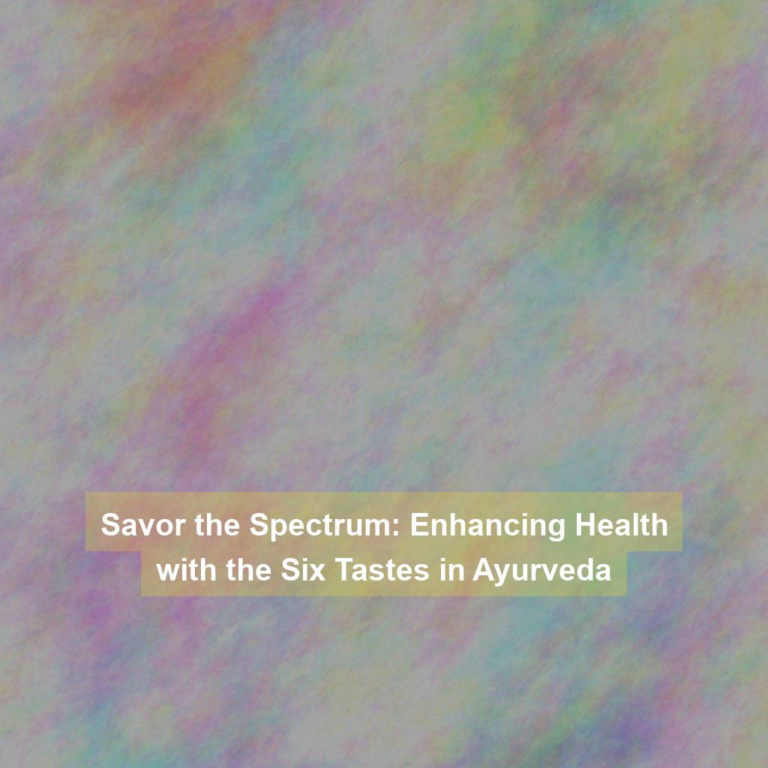You may not realize it, but the food you eat has a direct impact on the balance of your doshas. Understanding how to harmonize your doshas with Ayurvedic nutrition can be the key to achieving overall wellness and vitality.
By making simple adjustments to your diet and lifestyle, you can bring your mind and body into a state of equilibrium, promoting health and longevity. But how exactly can you achieve this harmonious balance?
Stay tuned to discover practical tips and strategies for tailoring your nutrition to support your unique dosha composition and enhance your well-being.
Understanding the Three Doshas
To understand the three doshas, you should think of them as fundamental energies that govern various functions in your body. Each dosha’Vata, Pitta, and Kapha’plays a vital role in your physical, mental, and emotional well-being.
Vata is associated with movement and is responsible for the flow of breath, blood, and thoughts. Pitta governs metabolism and is linked to digestion, absorption, and body temperature. Kapha provides structure and lubrication, supporting strength, immunity, and stability.
These doshas are present in every individual, but in varying proportions. When they’re in balance, you experience good health, but when they’re disturbed, it can lead to discomfort and illness. Understanding your unique doshic constitution can help you make informed choices about diet and lifestyle to maintain equilibrium.
Identifying Your Dominant Dosha
Understanding the three doshas has laid the foundation for identifying your dominant dosha, which plays a crucial role in shaping your unique constitution and well-being. To identify your dominant dosha, consider your physical, mental, and emotional tendencies. Reflect on your typical physical build, digestion, sleep patterns, and skin type.
Vata-dominant individuals often have a slender build, variable digestion, and dry skin. Pitta-dominant types tend to have a medium build, strong digestion, and warm skin. Kapha-dominant constitutions are usually characterized by a sturdy build, slow digestion, and oily skin.
Additionally, observe your mental and emotional traits. Vata-dominant individuals may be creative and prone to anxiety. Pitta-dominant types are often driven and may experience irritability. Kapha-dominant individuals are usually calm and nurturing but may struggle with attachment.
Balancing Vata, Pitta, and Kapha
Balancing Vata, Pitta, and Kapha requires a tailored approach to address the specific needs of each dosha in order to achieve optimal well-being and harmony. For Vata, focus on grounding, nourishing foods such as cooked grains, root vegetables, and warming spices to counteract its airy, light qualities. Pitta, on the other hand, benefits from cooling, hydrating foods like sweet fruits, leafy greens, and bitter herbs to balance its fiery nature. Kapha will thrive with pungent, stimulating foods like legumes, cruciferous vegetables, and light, dry grains to counter its heavy, slow qualities.
In addition to dietary adjustments, lifestyle practices play a crucial role in balancing the doshas. Regular exercise and movement help to release excess Vata, while Pitta benefits from calming activities like meditation and spending time in nature. Kapha can be balanced through dynamic, invigorating exercises and maintaining a consistent routine. By understanding the unique characteristics of each dosha and making targeted adjustments to diet and lifestyle, you can achieve a harmonious balance of Vata, Pitta, and Kapha for overall well-being.
Ayurvedic Nutrition Principles
Applying Ayurvedic nutrition principles supports the balance of Vata, Pitta, and Kapha by tailoring dietary choices to the specific needs of each dosha. In Ayurveda, food is considered medicine, and the right diet can help maintain harmony within the body and mind. The key principles of Ayurvedic nutrition involve eating according to your dominant dosha, favoring tastes that balance your dosha, and consuming fresh, whole foods.
When eating to balance Vata, emphasize warm, cooked foods that are grounding and nourishing. Choose sweet, salty, and sour tastes to pacify Vata. Pitta benefits from cooling, hydrating foods that aren’t too spicy or oily. Bitter, sweet, and astringent tastes are ideal for balancing Pitta. Kapha is best balanced by light, warm, and spicy foods that are stimulating and energizing. Choose pungent, bitter, and astringent tastes to pacify Kapha.
Additionally, practicing mindful eating, maintaining a regular eating routine, and honoring your body’s hunger and fullness signals are essential components of Ayurvedic nutrition. By following these principles, you can support the balance of your doshas and promote overall well-being.
Tailoring Your Diet to Your Dosha
To tailor your diet to your dosha, focus on choosing foods and flavors that align with your dominant dosha and support its balance, following the principles of Ayurvedic nutrition.
If your dominant dosha is Vata, opt for warm, grounding foods like root vegetables, whole grains, and warming spices such as ginger and cinnamon. Incorporating healthy fats like ghee and sesame oil can also help pacify Vata dosha.
For Pitta dosha, favor cooling and hydrating foods like sweet fruits, leafy greens, and cucumber. Minimize spicy and heating foods to keep Pitta dosha in check.
If Kapha dosha is predominant for you, emphasize light, stimulating foods such as legumes, bitter greens, and pungent spices like turmeric and cayenne pepper. Choosing foods that are less oily and heavy can help balance Kapha dosha.
It’s essential to listen to your body and observe how different foods affect your overall well-being, as individual variations play a significant role in tailoring your diet to your dosha.
Conclusion
Now that you understand your dominant dosha and the principles of ayurvedic nutrition, you can start making small changes to your diet to bring balance to your mind and body.
By incorporating foods and practices that align with your dosha, you can support your overall health and well-being.
Remember, it’s all about finding harmony and balance within yourself, and ayurvedic nutrition can help you achieve that.
So, start making those mindful choices and watch the positive impact on your life.







